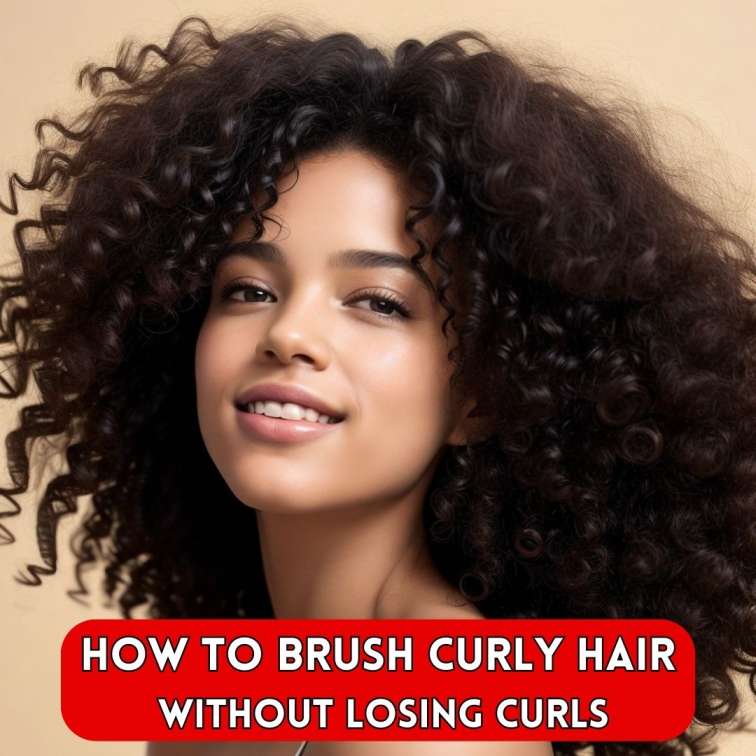Maintaining the natural beauty and definition of curly hair can be a challenge, especially when it comes to brushing. Many individuals struggle with the dilemma of keeping their curls intact while effectively detangling their locks. In this comprehensive guide, we will explore expert techniques and invaluable tips on how to brush curly hair without losing curls. By implementing these tried-and-tested methods, you can ensure that your brushing routine enhances the health, shape, and vibrancy of your curls, without sacrificing their natural allure.
[This post may contain affiliate links. What does that mean to you? Well, if you click on a product and make a purchase, I may get some compensation from you at no charge. If you want to read the boring stuff my full disclosure can be found here.]
Understanding Curly Hair
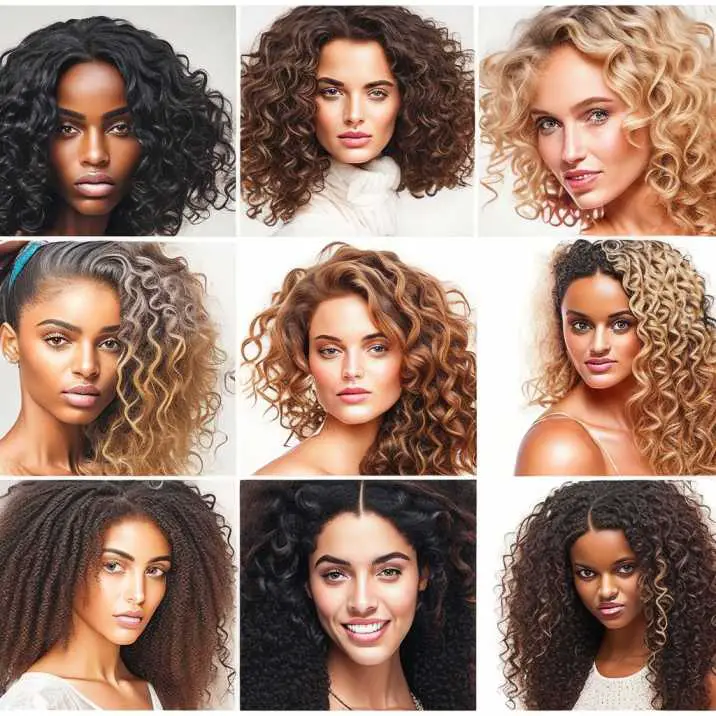
Before diving into the brushing techniques, it’s important to gain a deeper understanding of the unique characteristics of curly hair. Curly hair is distinct from straight hair due to its natural shape and texture. It often follows a spiral or S-shaped pattern, creating volume and bounce. However, curly hair is more prone to dryness, frizz, and tangling compared to straight hair. Let’s explore the different types of curly hair and discuss some essential care tips.
Types of Curly Hair
Curly hair can be categorized into various types, each with its own characteristics and care requirements. These types are commonly referred to as the “Curly Hair Chart” or the “Curly Hair Texture Typing System.” Here are the three main categories:
Type 2: Wavy Hair
- Wavy hair falls under the spectrum of curly hair types but has a looser curl pattern.
- It ranges from 2A (subtle waves) to 2C (defined, more pronounced waves).
- Wavy hair is generally more prone to frizz and can benefit from products that enhance definition while controlling frizz.
Type 3: Curly Hair
- Curly hair is characterized by well-defined curls that range from loose to tight curls.
- It ranges from 3A (loose curls) to 3C (tight, coiled curls).
- Curly hair tends to be more susceptible to dryness and requires regular moisturizing and conditioning.
Type 4: Coily Hair
- Coily hair is also known as kinky hair and has a tighter curl pattern.
- It ranges from 4A (tight, defined coils) to 4C (dense, tightly coiled hair).
- Coily hair is highly prone to dryness, shrinkage, and tangles. It thrives on moisture and requires careful handling and ample hydration.
Essential Care Tips for Curly Hair
Regardless of your specific curly hair type, there are some universal care tips that can help maintain its health and vitality:
Moisturize Regularly:
Curly hair tends to be drier due to its structure, so moisturizing is key. Use hydrating shampoos and conditioners specifically designed for curly hair. Consider incorporating a deep conditioning treatment at least once a week to replenish moisture and enhance elasticity.
Avoid Overwashing:
While it’s important to keep your scalp and hair clean, overwashing can strip away natural oils and contribute to dryness. Aim to wash your hair every 2-3 days or as needed to maintain a healthy balance.
Embrace the Co-Washing Method:
Co-washing, or conditioner-only washing, is a technique where you cleanse your hair with conditioner instead of shampoo. This method helps retain moisture while gently cleansing the hair, making it ideal for curly hair.
Pat Dry, Don’t Rub:
After washing, avoid vigorously rubbing your hair with a towel, as this can lead to frizz and breakage. Instead, gently squeeze out excess water and wrap your hair in a microfiber towel or an old t-shirt to absorb moisture without causing friction.
Apply Leave-In Conditioner:
After washing and towel-drying, apply a leave-in conditioner to seal in moisture and provide extra hydration. This step helps reduce frizz and enhances curl definition.
By understanding the unique characteristics of your curly hair type and following these care tips, you can establish a solid foundation for maintaining healthy, luscious curls.
Preparing Your Curly Hair for Brushing
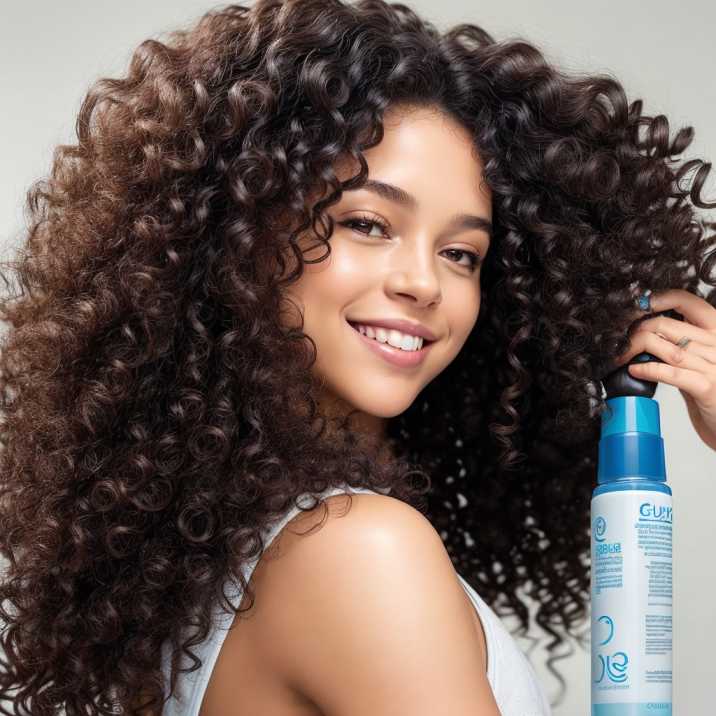
Before diving into the brushing techniques, it’s crucial to prepare your curly hair properly. This preparation step is essential for minimizing tangles, reducing breakage, and maintaining the integrity of your curls. Let’s explore some detailed tips on how to prepare your curly hair for brushing effectively.
Start with Clean, Conditioned Hair:
It’s important to begin the brushing process with clean hair to ensure optimal results. Choose a gentle shampoo that doesn’t strip away natural oils or weigh down your curls. Look for sulfate-free formulas specifically designed for curly hair. These shampoos help retain moisture and reduce frizz. Follow up with a nourishing conditioner to provide hydration, smoothness, and manageability to your curls.
Detangle with Care:
Curly hair tends to tangle easily, so it’s essential to detangle gently before brushing. Start by using your fingers or a wide-toothed comb to work through any knots or tangles. Begin at the ends of your hair and work your way up to the roots. This method helps prevent excessive pulling and breakage, which can disrupt your curl pattern.
Opt for the Right Detangling Tools:
When it comes to detangling curly hair, using the right tools is crucial. Consider investing in a wide-toothed comb or a detangling brush specifically designed for curly hair. These tools have wider gaps between the teeth or bristles, allowing for easier detangling without causing unnecessary tension. Look for combs or brushes made from materials like wood or flexible plastic, as they are less likely to cause static or damage to your curls.
Also Read-
- 20 Best Vegan Hair Care Products that Can Transform Your Hair in 2023
- 19 Ladies Beauty Parlour Interior Design Ideas
Detangle in Sections:
To make the detangling process more manageable, divide your hair into sections. This technique prevents overwhelming your hair and ensures that you thoroughly detangle every section. Start by separating your hair into two or more sections, depending on its thickness and length. Clip or twist each section to keep them separate while detangling. Working through one section at a time allows for better control and reduces the likelihood of missing tangles.
Use a Leave-In Conditioner or Detangling Spray:
Applying a leave-in conditioner or detangling spray can make the detangling process even easier. These products provide extra slip and moisture, making it smoother to comb through your curls. Look for lightweight leave-in conditioners or detangling sprays that won’t weigh down your hair. Apply the product to each section of hair before detangling, focusing on the ends where knots tend to accumulate.
Be Patient and Gentle:
Remember to be patient and gentle when detangling your curly hair. Rushing or forcefully combing through tangles can lead to breakage and disrupt your curl pattern. Take your time and work through each section slowly, starting from the ends and gradually moving upward. If you encounter stubborn knots, apply a more leave-in conditioner or detangling spray and use your fingers or a wide-toothed comb to gently work through them.
By following these detailed tips to prepare your curly hair for brushing, you’ll minimize tangles, reduce breakage, and set the stage for a successful brushing session that won’t compromise the natural beauty of your curls.
Selecting the Right Brush
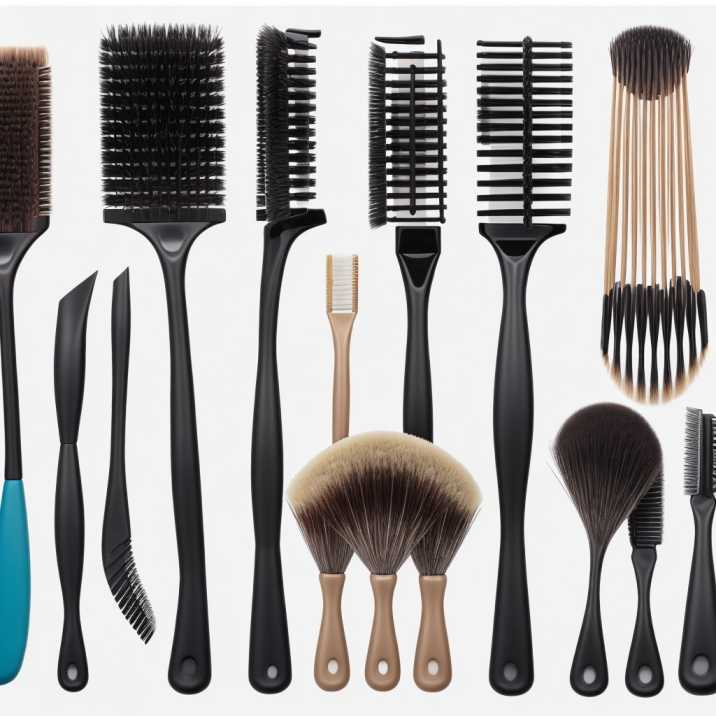
Choosing the appropriate brush is a crucial step in maintaining the health and shape of your curly hair while brushing. The right brush can detangle your curls without causing excessive breakage or disrupting your curl pattern. Here are some detailed considerations when selecting the right brush for your curly hair:
Bristle Material:
The material of the brush’s bristles can significantly impact how it interacts with your curls. Opt for brushes with gentle and flexible bristles, such as natural boar bristles or nylon bristles with rounded tips. These types of bristles are less likely to snag or damage your curls while detangling. Avoid brushes with metal or sharp bristles, as they can cause breakage and create frizz.
Brush Shape and Size:
The shape and size of the brush can also make a difference in how well it works with your curls. For curly hair, brushes with a wide surface area and large bristle spacing are generally recommended. Wide-toothed combs, paddle brushes with wide bristles, or Denman brushes are popular choices for detangling curly hair. These brushes allow for easy maneuverability through your curls and help preserve their natural shape.
Flexibility:
A brush with some flexibility is essential for curly hair. Look for brushes that have a slight give or bend when pressure is applied. This flexibility helps reduce the chances of breakage and allows the brush to glide through your curls more smoothly. Avoid brushes that are too rigid or stiff, as they can cause unnecessary tension and damage your hair.
Purpose-Specific Brushes:
Some brushes are specifically designed for curly hair and offer additional benefits. For example, detangling brushes with unique bristle formations or multiple lengths can effectively detangle curly hair without causing excessive pulling or breakage. These brushes work well with different curl patterns and textures. Look for brushes that are specifically marketed for curly hair or have features that cater to its unique needs.
Brushing Techniques for Curly Hair
Proper brushing techniques are essential for maintaining the shape and definition of your curls without causing damage or excessive frizz. By using gentle approaches, you can detangle your curly hair effectively while preserving its natural curl pattern. Let’s delve into detailed brushing techniques specifically designed for curly hair:
Finger-Combing Technique:
The finger-combing technique is a gentle method that allows you to work through your curls using your fingers. Start by sectioning your hair into manageable portions. Begin at the ends and use your fingers to carefully detangle any knots or tangles. Slowly work your way up towards the roots, gently separating the curls without disrupting their natural shape. This technique minimizes breakage and preserves the integrity of your curls.
Prayer Hands Method:
The prayer hands method is another effective technique for brushing curly hair. To begin, apply a leave-in conditioner or a detangling spray to add slip and moisture to your curls. Then, take a small section of hair between your palms, as if you’re about to pray. Gently glide your hands downward, allowing your curls to slip between your fingers. This method helps smooth the hair shaft and reduces frizz while maintaining the curl pattern.
Start from the Ends:
When brushing your curly hair, always start from the ends and work your way up toward the roots. This approach prevents unnecessary pulling or tugging on your curls, minimizing breakage. By starting at the ends, you can gradually remove tangles and knots without causing damage to the rest of your hair.
Use a Wide-Toothed Comb or Detangling Brush:
Instead of using brushes with fine bristles, opt for wide-toothed combs or detangling brushes specifically designed for curly hair. These tools help separate your curls gently without disrupting their natural formation. Begin by inserting the comb or brush at the ends of your hair, and with gentle motions, work your way upward to detangle and distribute natural oils evenly.
Detangle Wet or Damp Hair:
Curly hair is more manageable and less prone to breakage when it’s wet or damp. Consider brushing your hair immediately after showering or misting it with water to rehydrate it before brushing. Wetting the hair helps to soften and loosen any tangles, making the brushing process smoother and reducing the risk of damage.
Remember, patience is key when brushing curly hair. Take your time and be gentle with each stroke. Avoid rushing or forcefully brushing through your curls, as this can disrupt their natural pattern and lead to frizz or breakage. By incorporating these detailed brushing techniques into your routine, you can effectively detangle your curly hair while maintaining its beautiful curls.
Essential Tips for Maintaining Curls While Brushing
Maintaining the shape and integrity of your curls while brushing is crucial to preserve their natural beauty. By following these essential tips, you can ensure that your curls stay intact and minimize the risk of frizz or breakage during the brushing process:
Brush Wet or Damp Hair:
Brushing curly hair is best done when it’s wet or damp. Dry brushing can lead to excessive friction and breakage. Before brushing, either wash your hair or mist it with water to dampen it. Wetting the hair helps to soften the curls, making them more pliable and easier to detangle without causing damage.
Apply a Leave-In Conditioner:
Prior to brushing, apply a lightweight leave-in conditioner to your damp hair. Leave-in conditioners provide essential moisture, help reduce frizz, and make it easier to detangle. They also help protect your curls from breakage and maintain their shape. Look for leave-in conditioners specifically formulated for curly hair, and apply them from mid-length to ends, focusing on the areas prone to tangling.
Utilize a Detangling Spray:
If you find that your curls are particularly stubborn to detangle, consider using a detangling spray in conjunction with your leave-in conditioner. Detangling sprays provide extra slip and make it easier to glide through the hair without causing resistance. Look for sprays that are lightweight, non-greasy, and specifically designed for curly hair. Spray the product evenly throughout your hair before brushing.
Start from the Ends:
When brushing curly hair, always start from the ends and work your way up. Starting at the ends allows you to gradually remove tangles and knots without causing unnecessary stress or breakage to the rest of your hair. By working from the ends upward, you’re able to detangle each section effectively while minimizing damage to your curls.
Use Gentle Strokes:
When brushing your curls, use gentle, smooth strokes to avoid disrupting the curl pattern. Avoid forcefully pulling or yanking the brush through your hair, as this can lead to breakage and frizz. Instead, use slow and deliberate movements, gently working through each section until the brush glides smoothly. Take your time and be patient throughout the process.
Avoid Over-Brushing:
Overbrushing can cause excessive manipulation and disturb the natural shape of your curls. Once you’ve detangled your hair and achieved your desired style, refrain from excessive brushing. Excessive brushing can lead to frizz and unwanted volume. Instead, focus on maintaining your curls’ shape by refreshing them with your fingers or using a wide-toothed comb when necessary.
By following these essential tips, you can effectively maintain your curls while brushing and minimize the risk of damage or frizz. Remember to handle your hair with care, use the right products, and be mindful of your brushing technique. With proper maintenance, your curls will stay healthy, defined, and full of life.
Additional Care and Styling Tips for Curly Hair
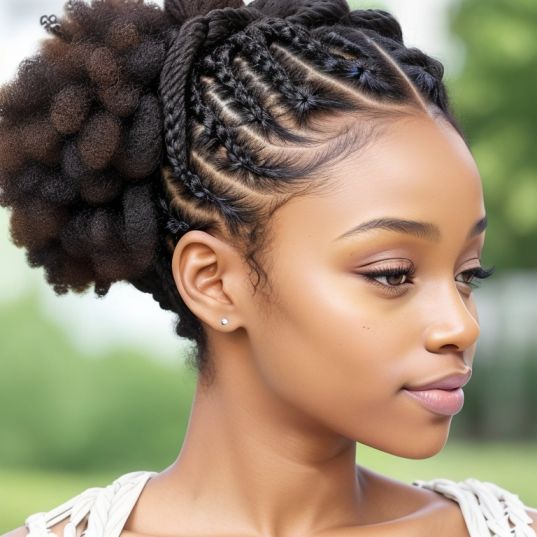
In addition to proper brushing techniques, incorporating extra care and styling practices into your curly hair routine can help enhance the health and appearance of your curls. Consider the following detailed tips to ensure your curls remain vibrant, well-maintained, and protected:
Regular Deep Conditioning Treatments:
Curly hair tends to be naturally drier, so regular deep conditioning treatments are essential. Deep conditioning helps nourish and moisturize your curls from within, keeping them hydrated and minimizing frizz. Look for deep conditioning masks or treatments specifically formulated for curly hair. Apply the treatment once a week or as recommended, allowing it to penetrate your hair for an extended period before rinsing it out. This extra dose of moisture will leave your curls feeling soft, supple, and revitalized.
Protective Hairstyles:
Protective hairstyles can help preserve your curls and minimize the need for excessive daily brushing. Consider styles like braids, buns, or twists, which can keep your hair neatly tucked away and protected from environmental stressors. These hairstyles also reduce manipulation, tangling, and exposure to friction, helping maintain the shape and definition of your curls. Experiment with different protective styles to find the ones that work best for your hair type and personal style.
Satin or Silk Pillowcases:
Traditional cotton pillowcases can create friction, leading to frizz and disrupting your curl pattern while you sleep. Switching to a satin or silk pillowcase can help reduce friction and prevent your curls from rubbing against rough surfaces. Satin or silk pillowcases are smoother, allowing your curls to glide effortlessly as you move during the night. This gentle contact can minimize tangles, frizz, and breakage, helping to maintain your curls’ shape and smoothness.
Overnight Curl Maintenance:
If you prefer wearing your hair down while you sleep, consider adopting overnight curl maintenance techniques. One method involves gently gathering your curls and securing them on top of your head using a loose, fabric-covered hair tie or scrunchie. This technique, known as the pineapple method, helps prevent flattening and preserves the volume and shape of your curls. In the morning, simply release the hair tie and gently shake out your curls to reveal refreshed, bouncy hair.
Limit Heat Styling:
Excessive heat styling can be damaging to curly hair, causing dryness, breakage, and loss of curl pattern. Whenever possible, embrace your natural texture and minimize the use of heat tools. Instead of relying on curling irons or straighteners, explore heatless styling methods like twist-outs, braid-outs, or air-drying techniques that enhance and define your curls naturally. If you do use heat styling tools, always apply a heat protectant spray beforehand to minimize damage.
Regular Trims:
Regular trims are essential for maintaining healthy, well-shaped curls. Trimming helps remove split ends and prevents them from traveling up the hair shaft, causing further damage. Aim for a trim every 8 to 12 weeks, or as needed, to keep your ends neat and prevent any potential breakage or fraying. Regular trims promote healthier hair growth and ensure that your curls remain vibrant and full of life.
By incorporating these additional care and styling tips into your curly hair routine, you can enhance the overall health and appearance of your curls. Regular deep conditioning, protective hairstyles, satin pillowcases, overnight maintenance, limited heat styling, and regular trims will contribute to the longevity and vitality of your curls, allowing them to shine with beauty and confidence.
Troubleshooting Common Issues with Curly Hair
Curly hair comes with its own set of challenges, and it’s important to address common issues that arise during the hair care and styling process. By troubleshooting these issues, you can effectively manage and overcome challenges specific to curly hair. Let’s explore some detailed solutions to common problems encountered by individuals with curly hair:
Excessive Shedding:
Experiencing more hair shedding than usual can be concerning. While it’s normal to shed a certain amount of hair daily, excessive shedding may indicate other underlying factors such as poor nutrition, hormonal imbalances, or scalp conditions. Ensure you’re maintaining a healthy diet, rich in essential nutrients for hair growth. If the shedding persists, it’s advisable to consult a healthcare professional or dermatologist for further evaluation and guidance.
Hair Breakage:
Hair breakage can occur due to several factors, including excessive manipulation, harsh brushing techniques, or dryness. To minimize breakage, handle your curls with care, opting for gentle brushing techniques and avoiding excessive pulling or tugging. Incorporate regular deep conditioning treatments to keep your curls moisturized and resilient. Additionally, limit the use of heat styling tools, as high heat can weaken the hair shaft and lead to breakage.
Knots and Tangles:
Curly hair is prone to tangling, especially when it’s dry or lacks moisture. To combat knots and tangles, ensure your hair is adequately hydrated by using moisturizing shampoos, conditioners, and leave-in products. Detangle your hair gently, starting from the ends and working your way up using your fingers, a wide-toothed comb, or a detangling brush. Applying a detangling spray or leave-in conditioner can provide extra slip and make the detangling process smoother.
Frizz Control:
Frizz is a common concern for curly hair due to its tendency to absorb moisture from the air. To control frizz, focus on maintaining moisture levels in your hair by using hydrating shampoos and conditioners and incorporating regular deep conditioning treatments. After washing your hair, gently squeeze out excess water and avoid vigorous towel-drying, as it can create friction and lead to frizz. Apply a styling product, such as a curl cream or gel, to help define and control frizz while enhancing your curls’ natural pattern.
Dryness and Hydration:
Curly hair often lacks natural moisture due to its structure, making hydration crucial. Use moisturizing products specifically formulated for curly hair, such as leave-in conditioners, curl creams, or hair oils. These products help lock in moisture and nourish your curls, keeping them hydrated and reducing dryness. Regular deep conditioning treatments are also vital for restoring and maintaining optimal moisture levels in your hair.
Scalp Issues:
Scalp conditions like dandruff or itchiness can affect individuals with curly hair. To address these concerns, maintain a clean scalp by using gentle shampoos and massaging your scalp regularly while washing your hair. Incorporate scalp treatments or clarifying products as needed to address specific issues. If problems persist or worsen, it’s advisable to seek advice from a dermatologist for a proper diagnosis and personalized treatment plan.
Styling Product Build-up:
Over time, styling products can accumulate on your hair, leaving a residue that weighs down your curls and affects their natural bounce. To prevent build-up, clarify your hair occasionally using a clarifying shampoo or a vinegar rinse. These products help remove any product residue, allowing your curls to regain their natural vitality. Remember to follow up with deep conditioning to restore moisture after clarifying.
By troubleshooting these common issues and implementing the appropriate solutions, you can overcome challenges specific to curly hair and ensure that your curls remain healthy, vibrant, and well-maintained. Remember, everyone’s hair is unique, so it’s important to experiment and find the methods and products that work best for you and your curls.
Embracing Your Natural Curls
Remember, your curly hair is unique and beautiful. Embrace your natural hair texture and celebrate the journey of loving your curls. Share your experiences and tips in the comments below to inspire others on their curly hair journey.
FAQs (Frequently Asked Questions)
Q1: How do you make curls stay after brushing?
To make curls stay after brushing, it’s important to use the right brushing techniques. Avoid brushing your hair vigorously and opt for gentle methods like finger-combing or using a wide-toothed comb. Additionally, applying a curl-enhancing product or a light-hold styling product can help maintain the shape and longevity of your curls.
Q2: Why do my curls fall out when I brush them?
Curls may fall out when brushed due to excessive manipulation, improper brushing techniques, or using the wrong type of brush. Brushing vigorously or using fine-toothed brushes can disrupt the curl pattern and cause curls to lose their shape. Opting for gentler techniques and using wide-toothed combs or brushes specifically designed for curly hair can help prevent curls from falling out.
Q3: How do I stop my curls from going flat?
To prevent curls from going flat, avoid over-brushing and excessive handling of your hair. Instead, scrunch your curls upward while they are damp to encourage bounce and volume. Using lightweight styling products like mousses or curl-enhancing creams can also help maintain volume and hold throughout the day. Consider sleeping with your hair in a loose bun or pineapple style to preserve your curls’ shape overnight.
Q4: Should I spray my curls before brushing?
It is generally recommended to avoid brushing dry curls. Instead, lightly mist your curls with water or a curl refresher spray to rehydrate them before brushing. This added moisture helps reduce frizz and makes the detangling process smoother. Additionally, applying a leave-in conditioner or detangling spray can provide extra slip and moisture to aid in detangling without disrupting your curls.
Q5: How long should curls sit before brushing?
Ideally, it’s best to let your curls sit undisturbed until they are completely dry before brushing. This allows the curls to set and retain their shape. If you need to detangle or refresh your curls before they are fully dry, do so with caution using gentle techniques and tools to avoid disrupting the curl pattern.
Q6: Does brushing hair destroy curls?
Brushing curly hair vigorously or using the wrong type of brush can potentially disrupt the curl pattern and cause damage, leading to the loss of curl definition. However, using gentle brushing techniques, such as finger-combing or using wide-toothed combs, can help detangle without destroying the curls.
Q7: Does brushing your hair ruin curls?
Brushing curly hair with harsh techniques or using the wrong type of brush can ruin the curl pattern and cause frizz or breakage. However, when done correctly with gentle methods and suitable tools, brushing can help maintain and enhance curls without ruining them.
Q8: How do you maintain curly hair?
To maintain curly hair, it’s important to follow a consistent hair care routine. This includes using hydrating shampoos and conditioners specifically formulated for curly hair, incorporating regular deep conditioning treatments, and avoiding excessive heat styling. Additionally, gentle detangling techniques, using suitable brushes or combs, and protecting your curls during sleep can help maintain their health and shape.
Q9: Is it better to comb curly hair wet or dry?
It is generally recommended to comb curly hair when it is wet. Wet hair is more pliable and easier to detangle without causing excessive breakage. However, be gentle when combing wet hair to minimize damage. If combing dry hair is necessary, use a wide-toothed comb or your fingers to avoid disrupting the curl pattern.
Q10: Should I comb my curly hair every day?
The frequency of combing curly hair depends on your hair type and personal preference. Some individuals may find that combing daily helps distribute natural oils and prevent tangling, while others may prefer to comb less frequently to minimize disruption to the curl pattern. It’s important to listen to your hair’s needs and adjust your combing frequency accordingly.
Conclusion
With the right techniques and products, you can brush your curly hair without losing those precious curls. Start by understanding your curly hair type and preparing it for brushing with gentle detangling tools. Use appropriate brushing techniques, and incorporate essential products like leave-in conditioners and detangling sprays to maintain curl integrity. By following these tips and embracing your natural curls, you’ll enjoy healthy, vibrant, and well-maintained curly hair.
